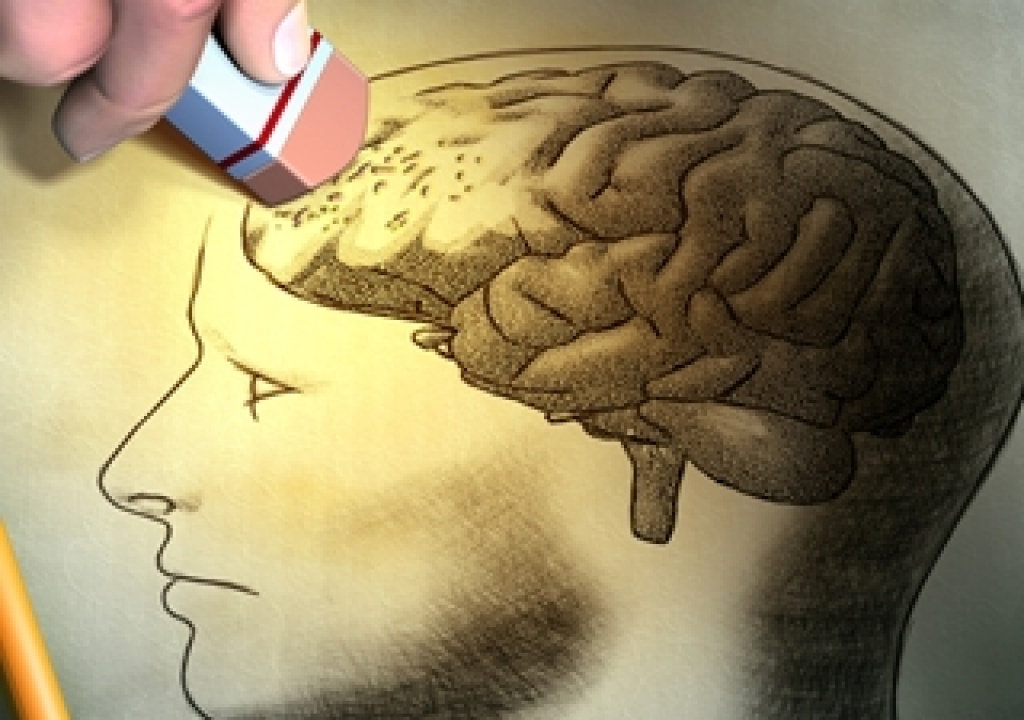
An illustration of memory loss
Memory loss is often referred as Amnesia, which means a partial or total loss of memory usually resulting from shock, fatigue, psychological disturbance, brain injury or other illnesses.
Memory loss can be reversible depending of its cause. When memory loss is irreversible then physicians start to rule out dementia.
Dementia is an overall term for a set of symptoms that are caused by disorders affecting the brain. Dementia is progressive, which means the symptoms will gradually get worse as more brain cells become damaged and eventually die.
Symptoms may include memory loss and difficulties with thinking problem-solving or language, severe enough to reduce a person’s ability to perform everyday activities. A person with dementia may also experience changes in mood or behaviors. People may think these symptoms are part of normal aging but they aren’t.
Dementia is not a specific disease. Some treatable conditions can produce symptoms similar to dementia, for example, vitamin deficiencies, thyroid disease, sleep disorders, or mental illness. It is therefore important to arrange for a full medical assessment as early as possible. Getting a timely diagnosis can help to access information, resources and support.
There are many different types of dementia, although some are far more common than others. Alzheimer disease in the most common type of dementias. Like any other form of dementia, Alzheimer’s disease is irreversible, progressive and destroys brain cells, causing thinking ability and memory to deteriorate.
The disease was first identified by Dr. Alois Alzheimer in 1906. He described the two hallmarks of the disease: (1) Plaques – are deposits of a protein called “beta amyloid”, or A-beta. When A-beta molecules accumulate and stick together, they form plaques which prevent signals from being transferred between nerve cells in the brain, ultimately causing the cells to die.
(2) Tangles – are fiber clumps of a protein called Tau. They eventually “choke” off the living cells. And when brain cells are damaged and die, the brain shrinks in some regions. As Alzheimer’s disease progresses and affects different areas of the brain, various abilities and behaviors become impaired. Once brain ability is lost, it is not known to return.
Each person is affected differently. It is difficult to predict which symptoms will happen, the order in which they will appear, or the speed of their progression. A person’s cognitive and functional abilities to understand, think, remember and communicate will be affected overtime.
The ability to make decisions will be reduced. Simple tasks that have been performed for years will become more difficult or be forgotten. Confusion and memory loss, initially for recent events and eventually for long-term events, will occur.
The ability to find the right words and follow a conversation will be affected. Sometimes people lose their way, even when walking in familiar surroundings. The first cognitive changes often happen a few years before the disease is actually diagnosed. It is important to remember that a person may still feel joy, anger, fear, love and sadness; even in the very late stages.
There is currently no cure for Alzheimer’s disease, nor is there a treatment that will stop its progression. Clinical trials are undergoing to identify ways to prevent and treat Alzheimer’s disease; however an early diagnosis is important as changing some lifestyle factors may have a greater chance of being helpful to slow down the progression of the disease.
For an early diagnosis; it is important to pay attention to the ten warning signs of Alzheimer’s disease. (1) Memory loss that affects day-to-day abilities; (2) Difficulty performing familiar tasks; (3) Problems with language; (4) Disorientation in time and space; (5) Impaired judgment; (6) Problems with abstract thinking; (7) Misplacing things; (8) Changes in mood and behaviors; (9) Changes in personality; (10) Loss of initiative.
Like any other illnesses affecting the brain functionality; individuals living with Alzheimer’s disease and other form of dementias, often feel excluded or treated differently. Stereotypes, stigma or misinformation can intimidate friends and family. It is important to be aware that negative reactions from friends, family and professionals can impact a person’s well-being and ability to manage the changes brought about by the disease.
Living with Alzheimer’s disease can be challenging. It is important to take steps to be as healthy as possible. Research shows that there are many things that can make health and quality of life better when living with Alzheimer’s disease. Lifestyle choices such as healthy eating, stress management, and physical and mental activity, can improve quality of life, may help to slow the progression of the disease and make it easier to manage the changes that the disease brings.
Chantal Mudahogora is a Therapeutic Counsellor at Alzheimer Society of Hamilton and Halton Ontario, Canada

